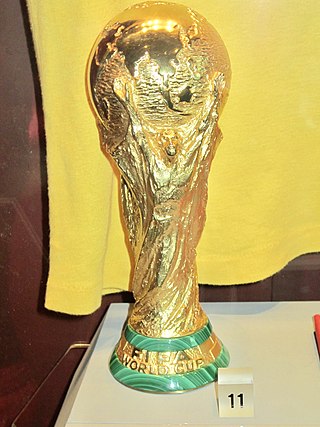
The World Cup is a solid gold trophy that is awarded to the winners of the FIFA World Cup association football tournament. Since the advent of the World Cup in 1930, two different trophies have been used: the Jules Rimet Trophy from 1930 to 1970 and thereafter the FIFA World Cup Trophy from 1974 to the present day. The production cost of the current trophy is estimated at $242,700.

The 1966 FIFA World Cup was the eighth FIFA World Cup, a quadrennial football tournament for men's senior national teams. It was played in England from 11 July to 30 July 1966. England defeated West Germany 4–2 in the final to win their first ever World Cup title. The final was level at 2–2 after 90 minutes and went to extra time, when Geoff Hurst scored two goals to complete his hat-trick, the first to be scored in a men's World Cup final. England were the fifth nation to win the event, and the third host nation to win after Uruguay in 1930 and Italy in 1934. Two time Reigning champions Brazil failed to get past the group stages as they were defeated by Hungary and Portugal. It was the first time that defending champions were eliminated in the group stages after Italy in 1950. This would not occur again until 36 years later.

Jules Rimet was a French football administrator who was the 3rd President of FIFA, serving from 1921 to 1954. He is FIFA's longest-serving president, in office for 33 years. He also served as the president of the French Football Federation from 1919 to 1942.

A trophy is a tangible, durable reminder of a specific achievement, serving as recognition or evidence of merit. Trophies are most commonly awarded for sporting events, ranging from youth sports to professional level athletics. Additionally, trophies are presented for achievements in Academic, Arts and Entertainment, Business, Military, Professional awards, Community Service, Hunting, and Environmental accomplishments. In many contexts, especially in sports, medals are often given out either as the trophy or along with more traditional trophies.

The National Football Museum is England's national museum of football. It is based in the Urbis building in Manchester city centre, and preserves, conserves and displays important collections of football memorabilia.
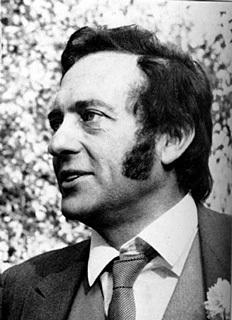
Harry H. Corbett was an English actor and comedian, best remembered for playing rag-and-bone man Harold Steptoe alongside Wilfrid Brambell in the long-running BBC television sitcom Steptoe and Son. His success on television led to appearances in comedy films including The Bargee (1964), Carry On Screaming! (1966) and Jabberwocky (1977).

Norbert Peter Stiles was an English footballer and manager. He played for England for five years, winning 28 caps and scoring one goal. He played every minute of England's victorious 1966 FIFA World Cup campaign. In the semi-final of that tournament against Portugal, he was given the job of marking the prolific Eusébio. His tough performance resulted in Eusébio being practically nullified for the entire game. Stiles also played in the final, which England won 4–2 against West Germany. His post-match dance on the Wembley pitch, holding the World Cup trophy in one hand and his false teeth in the other, was widely broadcast.
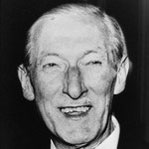
Arthur Drewry was an English football administrator who served as the fifth president of FIFA, the world governing body of association football, from 1955 to 1961. Drewry held several football administration posts in his native England, serving as chairman of The Football Association and president of The Football League.
The following are events in 1873 which are relevant to the development of association football. Included are events in closely related codes, such as the Sheffield Rules.
John "Joe" Mears was chairman of Chelsea Football Club and the Football Association.

Pickles was a black and white collie dog, known for his role in finding the stolen Jules Rimet Trophy in March 1966, four months before the 1966 FIFA World Cup was scheduled to kick off in England.
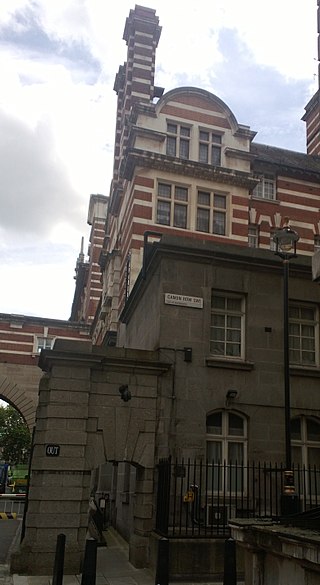
Canon Row Police Station in Canon Row, Westminster, was one of the Metropolitan Police's better known central London police stations. Replacing a leased station on King Street in St James's, it opened on 21 July 1902 in an extension to the Norman Shaw Buildings, then the home of New Scotland Yard. Canon Row Police Station was designed by the Metropolitan Police Surveyor, John Dixon Butler, with Richard Norman Shaw as consultant. The building is listed at Grade II*, and is no longer in use as a police station.
The 1965–66 season was the 86th season of competitive football in England.

Ottorino Barassi was an Italian sports official.
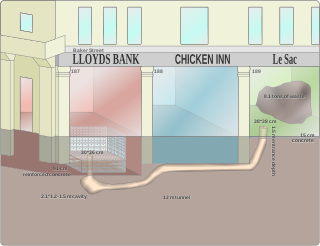
The Baker Street robbery was the burglary of safety deposit boxes at the Baker Street branch of Lloyds Bank in London, on the night of 11 September 1971. A gang tunnelled 40 feet (12 m) from a rented shop two doors away to come up through the floor of the vault. The value of the property stolen is unknown, but is likely to have been between £1.25 million and £3 million; only £231,000 was recovered by the police.
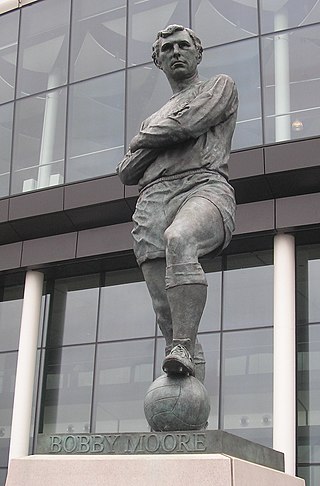
The Bobby Moore statue is a bronze sculpture of the former West Ham and England footballer Bobby Moore, situated directly outside England's national stadium, Wembley Stadium, in Wembley Park, north-west London. It commemorates the life of Moore, who captained the only England side ever to win the World Cup, defeating Germany 4–2 in the 1966 FIFA World Cup Final held in England at the old Wembley Stadium, demolished in 2003. Commissioned by the Football Association, it was unveiled outside the new stadium when it opened in 2007, fourteen years after Moore's death from cancer, aged 51. Standing 20 feet (6.1 m) tall on a stone plinth, it looks out over spectators as they walk down Wembley Way into the stadium. Sculpted by the Royal Sculptor Philip Jackson, it is Jackson's second piece featuring Moore, after the World Cup Sculpture unveiled in 2003.

The World Cup Sculpture, or simply The Champions, is a bronze statue of the 1966 World Cup Final located near the site of West Ham United Football Club's former Boleyn Ground stadium in the London Borough of Newham, England. It depicts a famous victory scene photographed after the final, held at the old Wembley Stadium in London, featuring Bobby Moore, Geoff Hurst, Martin Peters and Ray Wilson. It remains the only time the England national football team have won the World Cup, and England captain Moore is pictured held shoulder high by his colleagues, holding the Jules Rimet Trophy aloft.

In the early morning hours of March 18, 1990, 12 works of art were stolen from the Isabella Stewart Gardner Museum in Boston. Guards admitted two men posing as police officers responding to a disturbance call, and the thieves bound the guards and looted the museum over the next hour. The case is unsolved; no arrests have been made, and no works have been recovered. The stolen works have been valued at hundreds of millions of dollars by the FBI and art dealers. The museum offers a $10 million reward for information leading to the art's recovery, the largest bounty ever offered by a private institution.
The Jules Rimet Trophy was stolen for the second time in 1983. Unlike the first theft in 1966, the trophy has never been recovered.
Brian Henry Reader is a British gangster and villain, and has been described as "one of the busiest crooks in the British underworld" and a "ringleader" of the Hatton Garden safe deposit burglary in 2015.















